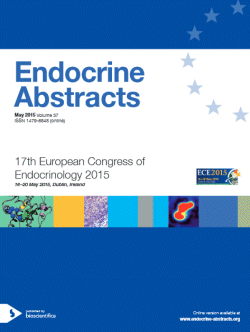Guided Posters
Endocrine tumours and neoplasia – General
ea0037gp.30.01 | Endocrine tumours and neoplasia – General | ECE2015
Temozolomide treatment for pituitary aggressive tumours and pituitary carcinomas: initial results and long-term follow-up of a cohort of 32 cases
Lasolle Helene , Castinetti Frederic , Cortet Christine , Cloix Lucie , Batisse-Lignier Marie , Bonnet Fabrice , Bourcigaux Nathalie , Chabre Olivier , Chanson Philippe , Delemer Brigitte , Lebrun-Frenay Christine , Garcia Cyril , Reznik Yves , Schillo Franck , Taillandier Luc , Maiter Dominique , Sadoul Jean-Louis , Caron Philipe , Raverot Gerald
ea0037gp.30.02 | Endocrine tumours and neoplasia – General | ECE2015
Clinicopathological significance of fractional allelic loss in prognosis of follicular cell-derived thyroid tumours
Migdalska-Sek Monika , Czarnecka Karolina H , Kusinski Michal , Pastuszak-Lewandoska Dorota , Nawrot Ewa , Kiszalkiewicz Justyna , Domanska Daria , Kuzdak Krzysztof , Brzezianska-Lasota Ewa
ea0037gp.30.03 | Endocrine tumours and neoplasia – General | ECE2015
The role of androgen receptor in glucose transporters expression in prostate cancer cells
Gonzalez-Menendez Pedro , Hevia David , Mayo Juan C , Sainz Rosa M
ea0037gp.30.04 | Endocrine tumours and neoplasia – General | ECE2015
Re-introduction of type 1 iodothyronine deiodinase in renal cancer cells affects their migration and expression of adhesion-related genes
Poplawski Piotr , Boguslawska Joanna , Kedzierska Hanna , Rybicka Beata , Tanski Zbigniew , Visser Theo J , Nauman Alicja , Piekielko-Witkowska Agnieszka
ea0037gp.30.05 | Endocrine tumours and neoplasia – General | ECE2015
Targeted destruction of FSHR-positive cells by lytic peptide Phor21 conjugated with FSHβ subunit in vitro
Chrusciel Marcin , Stelmaszewska Joanna , Ponikwicka-Tyszko Donata , Doroszko Milena , Wolczynski Slawomir , Huhtaniemi Ilpo , Ziecik Adam , Rahman Nafis
ea0037gp.30.06 | Endocrine tumours and neoplasia – General | ECE2015
The Wnt/β-catenin pathway regulates the expression of early embryonic stem cell genes in human parathyroid tumours
Verdelli Chiara , Forno Irene , Vaira Valentina , Guarnieri Vito , Scillitani Alfredo , Cetani Filomena , Vicentini Leonardo , Balza Gianni , Beretta Edoardo , Corbetta Sabrina
ea0037gp.30.07 | Endocrine tumours and neoplasia – General | ECE2015
Steroid metabolome analysis reveals that prostate cancer has potent 5α-reductase, 3α- and 17β-hydroxysteroid dehydrogenase activities, but lacks 17-hydroxylase/17,20-lyase
Hofland Johannes , Taylor Angela E , Turgeman Orli , O'Neil Donna M , Foster Paul A , Arlt Wiebke




